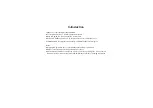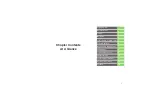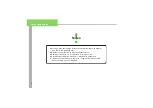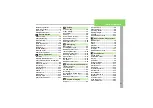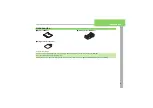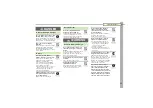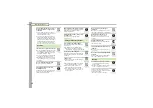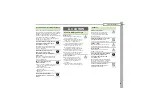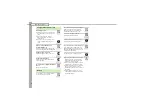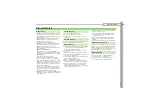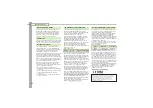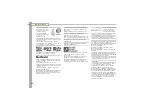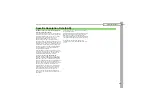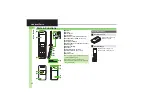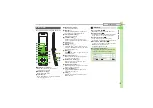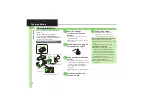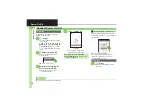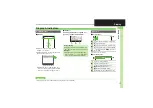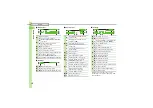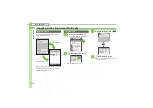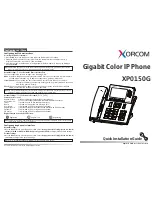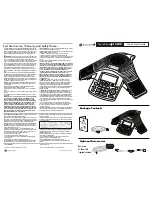
Safety Precautions
xii
For body-worn operation, this phone has been
tested and meets RF exposure guidelines when
used with accessories containing no metal, that
position handset a minimum of 15 mm from the
body. Use of other accessories may not ensure
compliance with RF exposure guidelines.
Changes or modifications not expressly approved by
the manufacturer responsible for compliance could
void the user's authority to operate the equipment.
This equipment has been tested and found to
comply with the limits of a Class B digital device,
pursuant to Part 15 of the FCC Rules. These limits
are designed to provide reasonable protection
against harmful interference in a residential
installation. This equipment generates, uses and can
radiate radio frequency energy and, if not installed
and used in accordance with the instructions, may
cause harmful interference to radio communications.
However, there is no guarantee that interference will
not occur in a particular installation; if this equipment
does cause harmful interference to radio or
television reception, which can be determined by
turning the equipment off and on, the user is
encouraged to try to correct the interference by one
or more of the following measures:
1. Reorient/relocate the receiving antenna.
2. Increase the separation between the equipment
and receiver.
3. Connect the equipment into an outlet on a circuit
different from that to which the receiver is
connected.
4. Consult the dealer or an experienced radio/TV
technician for help.
Your handset is a radio transmitter and receiver. It is
designed and manufactured not to exceed the
emission limits for exposure to radio frequency (RF)
energy set by the Federal Communications
Commission of the U.S. Government.
The guidelines are based on standards that were
developed by independent scientific organizations
through periodic and thorough evaluation of
scientific studies. The standards include a
substantial safety margin designed to assure the
safety of all persons, regardless of age and health.
The exposure standard for wireless handsets
employs a unit of measurement known as the
Specific Absorption Rate, or SAR. The SAR limit set
by the FCC is 1.6 W/k
g
.
Highest SAR value:
This device was tested for typical body-worn
operations with the back of the handset kept 1.5 cm
from the body. To maintain compliance with FCC RF
exposure requirements, use accessories that
maintain a 1.5 cm separation distance between the
user's body and the back of the handset. The use of
beltclips, holsters and similar accessories should not
contain metallic components in its assembly.
The use of accessories that do not satisfy these
requirements may not comply with FCC RF
exposure requirements, and should be avoided.
The FCC has granted an Equipment Authorization
for this model handset with all reported SAR levels
evaluated as in compliance with the FCC RF
emission guidelines. SAR information on this model
handset is on file with the FCC and can be found at
https://fjallfoss.fcc.gov/oetcf/eas/reports/GenericSearch.cfm
under the Display Grant section after searching on
the corresponding FCC ID (see table above).
Additional information on Specific Absorption Rates
(SAR) can be found on the Cellular
Telecommunications & Internet Association (CTIA)
Website at http://www.phonefacts.net.
Your mobile device is a radio transmitter and receiver.
It is designed not to exceed the limits for exposure to
radio waves recommended by international
guidelines. These guidelines were developed by the
independent scientific organization ICNIRP and
include safety margins designed to assure the
protection of all persons, regardless of age and health.
The guidelines use a unit of measurement known as
the Specific Absorption Rate, or SAR. The SAR limit
for mobile devices is 2 W/k
g
.
As mobile devices offer a range of functions, they
can be used in other positions, such as on the body
as described in this user guide
*
.
Highest SAR value:
As SAR is measured utilizing the device's highest
transmitting power the actual SAR of this device while
operating is typically below that indicated above. This is
due to automatic changes to the power level of the
device to ensure it only uses the minimum level required
to reach the Network. The World Health Organization
has stated that present scientific information does not
indicate the need for any special precautions for the use
of mobile devices. They note that if you want to reduce
your exposure then you can do so by limiting the length
of calls or using a handsfree device to keep the mobile
phone away from the head and body.
*
Please see Electromagnetic Waves on the left for
important notes regarding body-worn operation.
**
Measured in accordance with international
guidelines for testing.
Electromagnetic Waves
FCC Notice
Information to User
FCC RF Exposure Information
Model
FCC ID
At the Ear
On the Body
830SH
APYHRO00073
0.753 W/k
g
0.578 W/k
g
European RF Exposure Information
Model
At the Ear
**
On the Body
830SH
1.298 W/k
g
1.321 W/k
g
Here
b
y, Sharp Telecomm
u
nications of E
u
rope Ltd, declares
that
8
30SH is in compliance
w
ith the essential re
qu
irements
and other rele
v
ant pro
v
isions of Directi
v
e 1999/5/EC.
A copy of the original declaration of conformity for each
model can
b
e fo
u
nd at the follo
w
ing Internet address:
http://
www
.sharp.co.jp/k-tai/

